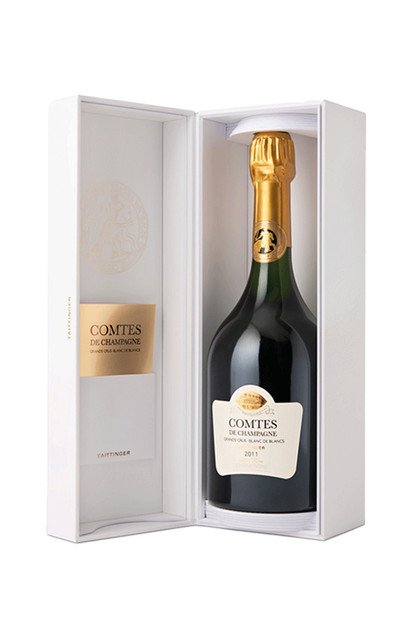Viewed 900 times...
Taittinger Comtes de Champagne 2011 Champagne
Short Description
This vintage is elaborated from Chardonnay wines exclusively, and from vineyards that are only classified Grand Cru from the Côte des Blancs.
This Champagne was solely elaborated during the best years, and when harvest was truly exceptional.
Only must (grape juice) from the first press are selected. 5% of the wines age for 4 months in new oak barrels (renewed by third every year). The wine is then bottled and brought in cellars in the Saint-Nicaise chalk quarries (13th century) located below the Reims hills, 18 metres deep, where it ages for 8 to 10 years.
The colour is a very pale yellow.
To the nose : the first attack is fruity and fresh, fine, like tangerine. Then are disclosed fragrances of ripe fruit, grilled brioche, dried raisins, and candied white fruits like vine peach.
The taste is smooth but bright with a balance between a full-bodied taste and touches of citrus like Florida pink grapefruit. The lingering finish is very fine with a spicy note going on liquorice and vanilla.
Works in perfect harmony with seafood, fine shellfishes or grilled/in sauce sea fishes.
In 1734, Jacques Fourneaux established a wine-business in Champagne and worked closely with the Benedictine Abbeys which, at that time, owned the finest vineyards in the region.
Jacques Fourneaux starts this activity in Reims, by trading still red or white Champagne wines, then sparkling wines from those wonderful vineyards.
In champagne’s history, he was the third to get into wine trading. The Fourneaux associate with Antoine Forest in the 1820s. Soon, the new company flourishes under the name Forest-Fourneaux.
For a while, it settles in the Vergeur hotel in Reims, before transferring the activity after the first world war on Tambour street, in the 13th century house of the Counts of Champagne.
In 1932, Pierre Taittinger bought the Château de la Marquetterie from the wine house of Forest-Fourneaux. From 1945 to 1960, the House was managed by François Taittinger with help from his two brothers Jean and Claude. It was at that time that the House settled in the Saint-Nicaise abbey’s cellars, built in the 13th century on roman chalk quarries from the 4th century. In 1960, Claude Taittinger managed and gave a great drive to the House.
After difficult times inside the group the restructure the stocks in the years 2005-2006, it was Pierre-Emmanuel Taittinger, a third generation who took over, with help from his two children Clovis and Vitalie, a fourth generation to write the future.
Taittinger’s vineyard spreads on around 300 hectares for a production amounting to 6 million bottles.
Long Description
| Details: | |
| Wikipedia: | Visit |
| Manufacturer: | ? |
| Origin: | |
| Barcodes: |

| Nutrition Facts | |||
|---|---|---|---|
| Serving Size: | |||
| Ammount per Serving: | |||
| Calories: | kcal | ||
| Details in % | Daily Value | ||
| Total Fat | % | g | |
| Satured Fat | % | g | |
| Trans Fat | % | g | |
| Polyunsatured Fat | % | g | |
| Monounsatured Fat | % | g | |
| Cholesterol | % | mg | |
| Sodium | % | mg | |
| Potassium | % | mg | |
| Total Carbohydrate | % | g | |
| Dietary Fiber | % | g | |
| Sugars | % | g | |
| Other carbohydrate | % | g | |
| Protein | % | g |

